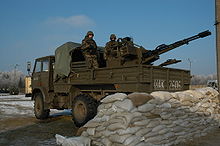SU-23
The SU-23 ( Russian ЗУ-23 , due to the English transcription also ZU-23 ) is a rifled anti-aircraft gun from Soviet production.
technology
Development of the SU-23 began in the late 1950s. The gun was to serve to defend troop accumulations and stationary facilities against low-flying aircraft and helicopters, and to a limited extent also as an anti-tank gun against ground vehicles. The gun consists of two parallel-mounted 23-millimeter machine guns of the type 2A14 on a wheeled chassis which is primarily intended for the attachment to a truck. Development models also included single and four-barrel variants, which, however, were never used in the armed forces. The chassis is based on the previous model SPU-2 (ZPU-2). In the combat position, the wheels are folded down so that the underside of the gun rests on the ground. The conversion from marching to combat function should be possible within 30 seconds, in emergencies also the firing of the gun that is still on its wheels.
Target acquisition and firing of the SU-23 are manual. The gun can be rotated 360 degrees. The opto-mechanical sighting device "SAP-23" offers limited aiming support. A telescopic sight is available for firing ground targets. The ammunition is fed to both tubes with belts from a 50-round container. The gun uses armor-piercing and high-explosive projectiles. The main difference between the cannon and the SPU-2 is its flash hider .
In 1960 the SU-23 entered service with the Soviet Army . There it was not only used as a towed vehicle, but also permanently mounted on various trucks and the MT-LB and BTR-DG armored personnel carriers and used from there.
The gun is currently in use in various variants by around 20 armed forces.
Data
- Caliber: 23 mm
- Dimensions (in battle position): 4.57 meters long, 2.88 meters wide, 1.22 meters high
- Weight: 950 kg
- Barrel length: approx. 2 meters, caliber lengths 87.3
- Muzzle velocity: 970 meters per second
- Bullet weight: 186 grams
- Rate of fire: theoretically 2000, practically 400 rounds per minute
- Range: 2500 meters, 2000 meters against ground targets
- Altitude range: 2000 meters
- Crew: six men
variants
Soviet Union
- SU-23 - original version
- SU-23M - version with modern aiming system (laser rangefinder, opto-mechanics and connections for TV and heat search target electronics)
Poland
- SU-23-2 - upgraded basic version with electro-optical aiming device and electric motor for rotating the gun
- ZUR-23-2S Jod - SU-23-2 with double launcher for anti-aircraft missiles of the type 9K32 Strela-2 M
- ZUR-23-2KG Jodek -G - SUR-23-2S with improved optics and double launcher for anti-aircraft missiles of the type "Grom"
- SU-23-2MR - SUR-23-2S for marine use
- Hibneryt - truck-mounted version with larger ammunition supply and improved engines for rotating the gun
Finland
- 23 ItK 95 - Improvements compared to the basic version
China
- Type 85 - replica of the SU-23-2
- Type 87 - replica of the SU-23-2 for 25-millimeter ammunition
Users
-
 Algeria - 60
Algeria - 60 -
 Armenia
Armenia
-
 Bangladesh
Bangladesh
-
 Bosnia and Herzegovina - 19
Bosnia and Herzegovina - 19 -
 Bulgaria - 128
Bulgaria - 128 -
 Cambodia
Cambodia
-
 People's Republic of China
People's Republic of China
-
 Cape Verde - 8
Cape Verde - 8 -
 Cuba
Cuba
-
 Egypt - 220 in the initial version and 350 with radar
Egypt - 220 in the initial version and 350 with radar -
 Estonia - 198
Estonia - 198 -
 Ethiopia - 10
Ethiopia - 10 -
 Finland - 1100
Finland - 1100 -
 Gabon - 24
Gabon - 24 -
 Georgia - 200
Georgia - 200 -
 Greece - 523
Greece - 523 -
 Guinea-Bissau - 16
Guinea-Bissau - 16 -
 India - 800
India - 800 -
 Indonesia
Indonesia
-
 Iran
Iran
-
 Hungary
Hungary
-
 Laos - 2
Laos - 2 -
 Lebanon
Lebanon
-
 Libya - 450
Libya - 450 -
 Morocco - 160
Morocco - 160 -
 Moldova
Moldova
-
 Mongolia
Mongolia
-
 Mozambique - 150
Mozambique - 150 -
 Nicaragua - 20
Nicaragua - 20 -
 Nigeria - 20
Nigeria - 20 -
 Pakistan - 500
Pakistan - 500 -
 Peru - 30
Peru - 30 -
 Poland - 408
Poland - 408 -
 Russia
Russia
-
 Serbia
Serbia
-
 Sri Lanka
Sri Lanka
-
 Tanzania - 40
Tanzania - 40 -
 Uganda - 5
Uganda - 5 -
 Ukraine
Ukraine
-
 Vietnam
Vietnam
-
 Yemen - 200
Yemen - 200 -
 Zimbabwe - 5th
Zimbabwe - 5th
literature
- Sunday Times (London). Insight Team, Insight on the Middle East was. Verlag A. Deutsch, 1974, ISBN 978-0-233-96566-6 .
- Andrew J. Pierre, Dmitriĭ Trenin: Russia in the world arms trade. Carnegie Endowment for International Peace, 1997, ISBN 978-0-87003-083-3 .
Web links
Individual evidence
- ↑ ZU-23 on militarium.net (Polish) ( Memento from June 12, 2010 in the Internet Archive )


